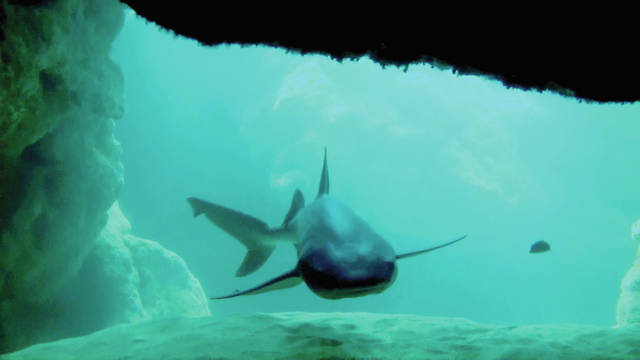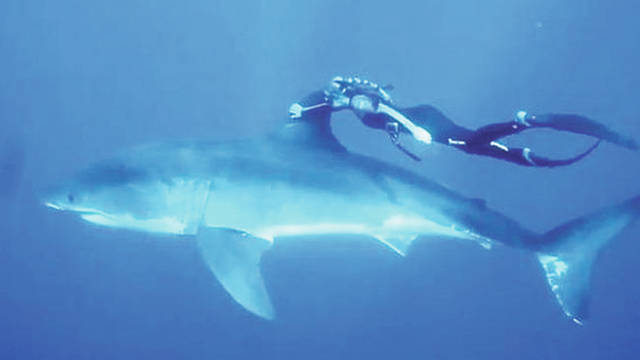LIHUE — Sharks are getting more air time on NatGeo Go Wild and some of the footage in the newest episode set to premier Sunday was shot by Terry Lilley of Kauai.
Lilley says he’ll be on camera, too, talking about “accidental shark bites and how best to avoid the problem.”
While the details are still secret, the focus of the episode will be on tiger shark attacks on surfers and snorkelers. Representatives with National Geographic didn’t return requests for comments on the show, slated for 8 p.m.
“My goal is to point out that these big sharks do not eat people and they only bite people when we are in the way of their food,” Lilley said. “I did not preview the show, so I hope they represent my love for sharks and the truth about Hawaiian sharks.”
Hawaii Institute of Marine Biology scientists who are studying shark-human encounters say the reason why sharks bite people is still a mystery.
“The truth is that nobody knows why sharks in Hawaii bite humans,” said Kim Holland, researcher and one of HIMB’s principal investigators on the long-term movement patterns of tiger sharks in Hawaii.
He continued: ”In one sense, it is mistaken identity because we know that humans are not a normal part of the diet of tiger sharks, the main culprits in Hawaii.”
HIMB scientists say tiger sharks primarily feed on shellfish, octopus and reef fish, turtles, marine mammals, reptiles and birds — and that guidelines aimed at reducing the risk of shark attack are based on behavior assumptions about the species that need reevaluation.
For instance, a common recommendation is to stay out of the water during feeding times like dawn, dusk and nighttime, but scientists say 67 percent of shark attacks occur in the daytime during the hours of 10 a.m. and 4 p.m.
That coincides with peak times of human activity in the water and HIMB scientists say we need to understand tiger shark long-term movement patterns to understand more.
Holland and other scientists with HIMB are quick to point out shark attacks are extremely rare when you take all the factors into account.
The International Shark Attack File reports an average of about 80 shark attacks worldwide annually. In 2017, for instance, the organization investigated 155 incidents of alleged shark-human interaction.
Of those 2017 reports, 88 were confirmed as shark attacks on humans and 30 were confirmed as provoked attacks, which means the attack happened after the human initiated contact with the shark.
The rest of the interaction can be chocked up to 18 boat attacks, two accounts of post-mortem bites, one account of someone being bit in a public aquarium and 16 unconfirmed or doubtful reports.
ISAF says white, tiger and bull sharks are the “big three” species most capable of attacks because they are large predators that are found in areas where humans enter the water.
In Hawaii waters, there are more than 40 species of sharks, many of which are threatened or endangered, primarily due to over-fishing, the illegal use of certain types of gear, such as gill nets, and marine entanglement, according to the Department of Land and Natural Resources.
When it comes to shark attacks, DLNR says only two have been reported this year.
The first occurred near Hawaii Island on March 31 at 9:30 a.m. when a tiger shark estimated at 12 feet in length reportedly bit a stand up paddle boarder in about 25 feet of turbid water. The shark took the victim’s right leg below the knee.
The second incident occurred 50 yards from shore at Shipwreck’s Beach in Poipu on April 19 when a body boarder was bitten by a tiger shark estimated at 8 feet in length in 15-20 feet of clear water at 8 a.m.
Six incidents were reported to DLNR in 2017, 10 in 2016 and 10 in 2015. The majority of those incidents were reported off the coast of Maui.
But, the ISAF points out “identification of attacking sharks is very difficult since victims rarely make adequate observations of the attacker during the heat of interaction.”
HIMB says the trend stays true to Hawaii, where tiger sharks are “frequently implicated in attacks on humans … although shark attacks are extremely rare overall.”
“We know that tiger sharks are in Hawaii waters year round and we know there are thousands of people in the ocean every day. However, there are only a handful of attacks every year,” Holland said.
Humans may pose more of a danger to sharks than the other way around, according to some scientists — like hammerhead sharks, which are prized for their fins, craved as a delicacy on the table.
Hawaii enacted the nation’s first and strongest shark finning and products ban in 2010 and continues legislative efforts to increase the penalties for intentionally killing sharks or rays in Hawaii waters.
NatGeo Wild claims a dedication to “providing a unique insight into the natural world” through footage from Earth’s most remote settings, according to their mission statement. The channel’s goal is also to show how humans interact with the natural world and footage about that human-shark connection is Lilley’s focus for the episode.
Lilley said sharks are selective about what they eat but can be trained regarding their diet.
“In Hawaii we have some invasive fish called roi. Our local sharks do not seem to want to eat them! In the Caribbean there is an invasive fish called a lionfish that their sharks do not seem to want to eat,” he wrote.
Over a three-year shark training project, he said sharks began eating the lionfish, another invasive fish, and the same could be done here.
“So maybe we can work with our local sharks to help them realize that roi are good to eat and have our shark friends work with us humans that have messed up their environment,” he wrote.
Key information that came about from the Caribbean project and the Nat Geo show is that sharks are important for the health of the ocean environment, Lilley said.
“They have no need to eat people and may just have a need to cooperate with people so we can have a sustainable future for us all in the sea,” he said.



